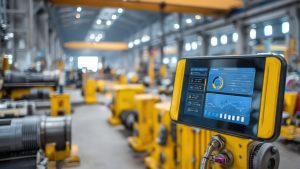The Future of AI in Asset Maintenance Management is not just a buzzword; it’s a game-changer for businesses. You might question the need for change, especially with a seemingly effective maintenance program already in place. However, the evolving capabilities of artificial intelligence are making traditional methods appear outdated and inefficient. The true potential of AI in asset maintenance lies in its ability to anticipate and address potential problems before they arise, revolutionizing the way we approach maintenance.
Recent surveys demonstrate that this is more than just industry hype. A significant 30% of CFOs have already incorporated AI-driven solutions, while a majority (55%) are actively exploring implementation strategies. This growing trend highlights the tangible benefits and real-world impact of AI in various sectors, including facility maintenance, optimizing asset performance, and improving maintenance operations.
Artificial intelligence is transforming asset management in several innovative ways, impacting various maintenance activities:
Predictive Maintenance: The Game Changer

AI utilizes real-time data from sensors, repair histories, and operational logs to identify patterns and anticipate potential equipment failures. Often, machinery exhibits subtle signs of wear and tear, such as slight temperature fluctuations or unusual vibrations, which can be easily missed by human observation.
This is where AI comes in. It detects these subtle indicators, alerting maintenance teams in advance. AI doesn’t just react; it proactively predicts potential issues. The interest in such advanced solutions is growing, with early adopters already experiencing the advantages. A significant example highlights the cost of unplanned downtime, estimated at a staggering $50 billion annually. Equipment failures contribute to a considerable 42% of these outages. AI’s predictive capability allows businesses to address problems proactively, minimizing costly disruptions.
Better Decision Making: Say Goodbye to Gut Feelings
Traditionally, decisions regarding asset management, such as repair, replacement, or resource allocation, were often based on intuition and experience. This led to inefficiencies, with resources sometimes being wasted on unnecessary repairs or, conversely, critical failures occurring due to delayed action.
AI removes the guesswork by analyzing vast amounts of data, providing data-driven insights to facilitate informed decisions. From determining the optimal time for equipment replacement to optimizing production schedules, AI empowers businesses with the information needed for confident decision-making. Studies by the Boston Consulting Group indicate that such data-driven decisions can lead to substantial improvements in EBITDA, demonstrating the tangible financial benefits of AI-powered insights.
Supercharge Your Team, Not Replace It

The goal of AI in asset management is not to replace human teams but to enhance their capabilities. This technology streamlines maintenance work, making processes more efficient and allowing maintenance personnel to focus on specialized tasks.
Take inventory management, for example. Imagine an AI-powered system that automatically reorders spare parts when they are low in stock, eliminating the need for manual monitoring and last-minute scrambling. AI frees up valuable time and resources, enabling teams to prioritize complex problem-solving and critical maintenance activities.
Benefits of AI in Asset Management
Implementing AI in asset maintenance management offers several key advantages:
Boosted Productivity: Work Smarter, Not Harder
Automation, driven by AI, takes care of repetitive tasks, increasing the overall efficiency of maintenance operations. Imagine reports being generated in seconds and equipment checks being conducted with consistent accuracy – this is the power of AI-driven automation.
This leads to significant cost savings. Studies suggest potential reductions in maintenance costs of between 15-30% through the adoption of such technologies, highlighting the financial benefits of incorporating AI into asset management strategies.
Reduced Downtime: Keep Your Operations Humming

In sectors like industrial manufacturing, unplanned downtime can be detrimental, leading to financial losses and impacting customer satisfaction. AI plays a crucial role in ensuring the smooth running of operations by predicting and mitigating potential disruptions before they occur.
Beyond just financial savings, reducing downtime leads to a more streamlined and efficient workflow. By minimizing unexpected disruptions, AI allows businesses to optimize their production processes and improve overall operational efficiency.
Enhanced Safety: A More Secure Work Environment
Creating a safe work environment is paramount. A majority of manufacturing professionals believe their safety programs could be improved. AI can significantly contribute to this by continuously monitoring equipment for potential hazards.
Predicting equipment failures not only ensures operational continuity but also significantly improves workplace safety. This proactive approach fosters a more secure environment, reducing the risk of accidents and enhancing overall worker well-being.
Navigating Challenges & Embracing a Transformative Future

While the future of AI in asset management is promising, it’s not without its hurdles. Businesses may have concerns about data security, initial investment costs, or the need for comprehensive team training.
Successfully implementing AI requires commitment and collaboration. Clear and open communication across all levels of a team is crucial, ensuring everyone understands and embraces the new technologies. When employees are well-informed and adequately trained, the transition to AI-powered systems is smoother, and the technology’s potential can be fully realized.
Don’t let potential challenges deter you. The future of AI in asset maintenance is full of potential. By embracing AI, you open doors to streamlined operations and improved maintenance practices, setting the stage for long-term growth and efficiency.
FAQs about The Future of AI in Asset Maintenance Management
How is AI used in maintenance management?
AI, utilizing big data and machine learning, analyzes historical equipment data to identify patterns and make predictions about potential equipment failures. This technology helps in making informed decisions about maintenance schedules, spare parts management, and resource allocation.
How will AI affect asset management?
AI is transforming asset management by introducing a proactive approach to maintenance. It allows for predictive maintenance, reduces downtime, and helps businesses optimize their maintenance strategies. The result is improved operational efficiency, reduced costs, and enhanced workplace safety.
What will asset management look like in 10 years?
The future of AI in asset management is bright. In the next decade, expect to see even greater integration of AI-based systems into various business operations. From sophisticated predictive analytics to the increased use of autonomous devices, the asset management landscape will be shaped by the power of AI.
What is the future of AI in inventory management?

The future of AI in inventory management promises to be transformative, offering innovative solutions that can significantly enhance how businesses handle their inventory. AI technology is set to revolutionize inventory management in several key ways:
- Demand Prediction: AI-powered systems utilize advanced algorithms and machine learning to analyze historical sales data, market trends, and other relevant factors. This enables accurate demand forecasting, helping businesses anticipate customer needs more effectively and avoid both overstocking and stockouts.
- Automated Replenishment: With AI, replenishment processes can be fully automated. AI systems can monitor inventory levels in real-time, predict when stock will run low, and automatically place orders to suppliers. This reduces the risk of human error and ensures that inventory is always at optimal levels.
- Optimized Inventory Levels: AI algorithms can dynamically adjust inventory levels based on demand forecasts, seasonal trends, and other variables. This optimization minimizes excess inventory and associated carrying costs while ensuring that critical items are always available when needed.
- Cost Savings: By improving demand accuracy and automating replenishment, AI reduces operational costs related to excess inventory, warehousing, and stockouts. This leads to more efficient use of resources and significant cost savings for businesses.
- Improved Efficiency: AI enhances operational efficiency by streamlining inventory management processes. Automated systems reduce manual labor, improve accuracy, and speed up inventory tracking, leading to more efficient warehouse operations and better customer satisfaction.
- Resilient Supply Chain: AI contributes to a more resilient supply chain by providing real-time insights and early warnings about potential disruptions. Predictive analytics help businesses prepare for and mitigate the impact of supply chain issues, ensuring continuity and stability.
Overall, AI’s integration into inventory management represents a significant advancement, offering businesses a competitive edge through enhanced accuracy, efficiency, and cost-effectiveness. As AI technology continues to evolve, its role in inventory management will likely expand, driving further innovations and improvements in how businesses manage their supply chains.
Conclusion
The future of AI in asset management, especially in predictive maintenance, holds remarkable promise. As businesses look to integrate risk management and smart maintenance strategies, AI offers a transformative approach to handling work orders and optimizing asset performance. By leveraging insights from case studies and real-world applications, asset managers can harness AI to enhance portfolio management and make data-driven decisions that improve safety, streamline workflows, and optimize resource allocation. Additionally, financial generative AI is reshaping financial services by providing deeper insights and better risk assessment capabilities. Embracing AI not only positions companies for long-term success but also ensures the sustainability and efficiency of their operations, ultimately boosting their bottom line and securing a competitive edge in the market.
Topic: The Future of AI in Asset Maintenance Management: A Guide



